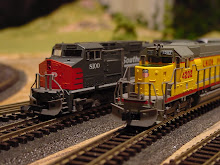Life took precedence over the transfer table staging project, and progress on that got postponed for at least a month or two. In the meantime, I had a more immediate issue. I’m about 40% done with the small layout, and it’s gotten to be quite boring watching the trains run around and around. I needed an operating scheme fast to keep the interest alive on that layout. And, it had to be something simple so that the kids can play along. Elaborate switch lists and multiple stop waybills were going to be too complicated.
I tried hard, but couldn’t come up with a realistic operating scheme. So, I decided to look at the prototype for inspiration. Since I needed simpler operations, a branch line would be perfect. I also wanted it to be something that the kids could relate to. So, I decided to look at present day local railroads located in the Pacific Northwest, preferably in the State of Washington.
After combing the web, I found the following resources to be the most useful:
After combing through most of this, I found that one of the most intriguing short lines was the Puget Sound and Pacific Railroad. The railroad interchanges with both UP and BNSF at Centralia. Its trains run up to Elma where the railroad is headquartered. Here, the line splits into two branches, one going west to Hoquiam and another going north to Bremerton. The one other junction is the Bremerton junction, just north of Belfair. Click here to see their system map.
The major customers are the lumber companies, waste, food etc. They also service the Puget Sound Naval Shipyard in Bremerton, and the Bangor Naval Base.
I then started researching the industries that had active spurs (according to Bing and Google maps) on the PSAP lines. Of all the industries, I decided to go with the following (all of which exist unless otherwise noted).
- Sierra Pacific
- Weyerhauser
- CFN Pacific Pride Petitt Oil Co.
- Olympic Oyster Co. (imaginary)
- The Three Chocolatiers (imaginary)
- Cascade Plastics (imaginary)
- Minder Meats
- Viking Fence Co.
- Puget Sound Naval Shipyard
- Bangor Naval Facility
Of all these industries, only 4 of them would be represented on the layout. The Three Chocolatiers (because, the kids wanted it) and Cascade Plastics (to generate hopper traffic) will have their own spurs. Minder Meats and Viking Fence Co. will be represented with the third spur on the layout, which is a team track.
Ok, now that I had a prototype that matched my criteria, how on Earth was I going to represent that on a railroad that is only 24”x44”? I knew that I was going to have to reuse much of the track; the same passing siding will need to be two different locations based on where you are on the map. This is the track layout for my railroad:

After analyzing the PSAP map and looking at my own layout for hours on end, I came up with the following operating schematic:

This is how my schematic maps to the actual PSAP system map:

Now, let me show you how that track schematic maps to the actual track arrangement that I have on my layout. First off, let’s go over the part from the Centralia to Cedarville. This area is quite scenic on the actual PSAP and runs parallel to a river. Great for my trestle scene. The tunnel was a stretch, but isn’t everything a bit of a stretch in a project like this? The entire Centralia yard is represented with the short spur on the lower left (which happens to be a cassette dock) and the passing siding.

Next is the junction at Elma. The yard at Elma is represented by a single long spur and the passing siding. Trains headed for Hoquiam drop off any cars destined towards Bremerton at the Elma yard and then keep going on the outer loop to cassette staging.

Then comes Shelton, where the imaginary Three Chocolatiers is located and the Bremerton Junction where the line again splits into two. The passing siding now takes on its third role as the junction. The inner loop becomes the PSAP line going north to Silverdale and Bangor Naval Base, and the outer loop becomes the line going east to Bremerton. Here the engine can cut the cars destined for Silverdale/Bangor at the passing siding and take the cars destined for Bremerton on the outer loop to cassette staging. Then it comes back to pick up the cars on the passing siding and continue on North on the inner loop.

Finally, we reach Silverdale where the most industrial switching will occur. After switching the two spurs at Silverdale, the engine continues on towards Bangor Naval Base on the inner loop all the way to cassette staging.

For returning trains, the operation is very similar, but in reverse, with everything terminating at Centralia Yard.
I prepared the following system map to use as reference. This is now hanging above the railroad. What on earth is MKT stuff doing there you might say. Well, did I mention this layout is mostly for the kids? Well, the UP Heritage “Katy” SD70ACe happens to be their favorite engine, and the GP40 MKT just looks way too cool.

Creating this operating scheme was a very satisfying experience. It just goes to show you that no matter how small your layout is, you can still come up with a very realistic operating scheme based on the prototype. This is possible, even if you didn’t start out with an operating scheme in mind, as was the case here.
Next up, I will cover the extremely simplified car routing system I came up with to support these operations.















